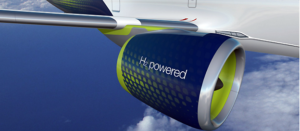Hydrogen Fueled Commercial Flight – Cause and Effect
As Hawaii moves to a zero emissions, zero carbon economy, beginning with the electrification of ground in transportation, there is a much greater challenge ahead for the remote island state. Just how best to address aircraft emissions. One often cited answer, it will be the airlines, passenger jet and engine manufacturers who decide what and when hydrogen fuel planes become a reality, rather than lofty state ambitions that can be summed up in two words: hydrogen fuel.

Today, jet fuel varies widely, but is based on a petroleum source, and in all cases pollutes the air and is a substantial contributor to climate change. EPA reports that commercial airplanes and large business jets contribute 10 percent of U.S. transportation emissions, and account for three percent of the nation’s total greenhouse gas (GHG) production.
Experimental hydrogen-fueled aircraft so far have been in the form of liquid hydrogen (LH2), serving as a full replacement for conventional jet fuel, and with the goal of eliminating GHG emissions and pollution associated with today’s jet fuels.
Hydrogen-fueled aircraft emit emissions primarily comprised of water vapor (H2O), nitrogen oxides (NOx), and unburned hydrogen. If LH2 is produced in a climate and carbon-neutral manner, carbon dioxide does not have to be included when calculating the climate footprint.

However, what happens when water vapor enters the atmosphere through hydrogen-fueled aircraft engines, rather than through natural evaporation from rivers, lakes, and oceans? Science is discovering that it directly contributes to anthropogenic global warming in the same way that carbon dioxide (CO2) does—especially if it forms long-lasting contrail cirrus clouds at high altitudes.
So do Hydrogen-fueled aircraft create and add to climate problems already out of control, and accelerate climate change?
Early data indicates the answer may be yes.
Unlike most small and private passenger aircraft, commercial aircraft fly at high altitudes both long and short distances. Experimental aircraft at the commercial scale employing fuel cells and engines that burn hydrogen and release large amounts of water in the form of vapor contribute to the problem of contrails.
A study that looked at aviation’s contribution to climate change between 2000 and 2018 concluded that contrails create 57% of the sector’s warming impact, significantly more than the CO2 emissions from burning fuel. They do so by trapping heat that would otherwise be released into space.

Already recognized as a significant climate contributor associated with commercial jet traffic, contrails – short for condensation trails, form when water vapor condenses into ice crystals around the small particles emitted by jet engines – require cold and humid atmospheric conditions, and don’t always stay around for long.
Researchers say that by targeting specific flights that have a high chance of producing contrails and varying their flight path ever so slightly believe much of the damage could be prevented.
Recent scientific data suggests commercial flight contrails’ contribute to climate impacts and are associated with 10% of all flights. Simply redirecting a small proportion of flights could make a substantial dent in contrail climate impact. However, this finding is limited to conventionally-fueled aircraft and does not consider the added climate effects off high altitude and jet-induced water emissions through a switch to hydrogen fuel. Whether the rerouting of flights will have any effect on the problem of added water vapor from hydrogen emissions, only further compounds the unknowns an already assoicated with today’s climate problems associated mostly with commercial flights.
H2O Ground Transportation – promise or a road not taken
Ground transportation’s migration off fossil fuels has recently taken several forms. The most successful and promising has been zero emissions BEV’s (battery electric vehicles), and with the most notable and innovative being Tesla – a company now being chased by most of the auto industry.
Hydrogen-fueled semi-trucks, buses, and trains are for the most part at the nascent stage of development and are often cited by their promoters as the answer to the question of how zero emissions and hydrogen-fueled large-scale ground transportation applications can best address the limits of today’s battery-powered vehicle technology. But, even that statement is debated, considering an industry-wide battery technology rush also being led by Tesla’s all-battery 600 mile range Semi truck, with its 80,000-pound commercial towing capacity, now competitive with conventional diesel commercial trucks.
Most railroads have for over 50 years successfully employed diesel-electric engines (hybrid) technology for short and long haul freight traffic. US Department of Energy’s Lawrence Berkeley National Laboratory (Berkeley Lab) recently made the case for diesel-electric trains in the United States to be retrofitted with batteries, and in a way that is more than cost-competitive with today’s diesel-hybrid engines. Doing so would also decrease adverse health impacts and premature deaths linked to air pollution, and eliminate CO2 and other GHG emissions.
Hydrogen fuel holds great promise for future transportation applications in general, but as other clean fuel transportation technologies now take center stage (with battery- electrics leading the way) questions of efficiency, cost, performance, and in the case of flight climate impacts from this fuel alternative require further study and experimentation before the promise of this fossil fuel alternative, and the expectations that accompany it, are validated or dismissed.




Leave a Reply
Join the Community discussion now - your email address will not be published, remains secure and confidential. Mahalo.